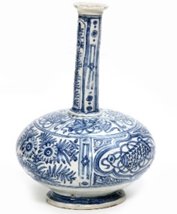Garrafa
Faiança portuguesa
Lisboa, 1610 – 1620
Alt.: 30 cm
Prov.: P.C., Lisbon
Expo.: ‘Un Siècle en Blanc et Bleu’, Paris, 2016
Pub.: ‘Lisboa na Origem da Chinoiserie’, Lisboa, 2018, p. 58
Bottle
Portuguese faience
Lisbon, 1610–1620
H.: 30 cm
Prov.: P.C., Lisbon
Exhib.: ‘Un Siècle en Blanc et Bleu’, Paris, 2016
Pub.: ‘Lisboa na Origem da Chinoiserie’, Lisbon, 2018, p. 58
Rare Portuguese faience bottle copying an Islamic model, with decoration inspired by Chinese porcelain pieces.
The large rounded body, with decoration in cobalt-blue over white glaze, is divided in four cartouche like sections alternating floral patterns and geometric motifs with ribbons and loops. Placed in between these sections, four vertical frames with hanging double cords and lozenge patterns. The wide shoulder is equally divided in four sections of paper scrolls and ribbons, combined with stylized flowers within a narrow vertical column.
The narrow vertical panels on the long cylindrical neck, alternating long leafy stems with a flowering daisy and double hanging cords with lozenge, a highly precious object of Buddhist mythology.
Unequivocally this elegant bottle adopts a well identified Islamic shape and a Wanli decorative grammar, which it attempts to copy accurately in its profusion of motifs and symbols.
The Portuguese were well familiarized with the Wanli period (1572-1620) porcelain objects that were imported in large quantities throughout the first half of the 16th century. This intense co-existence resulted in a considerable level of assimilation, expressed not only by the excellent quality of the faience pieces produced, often similar to porcelain, but also by the decorative compositions carefully copied from Wanli models.
This unique porcelain like quality was achieved by the careful kneading of the fine clay that allowed for thin walled coiling or wheel-throwing, the choice of the finest cobalt-blue pigments, the purity of the glaze and the superb quality of the painting.
Only two other pieces of identical shape are so far recorded. One of similar size in the Cologne Museum (inv. E531, 11351–11408) and another in a European private collection.
Extraordinária e raríssima peça em faiança portuguesa de formato islâmico e com decoração inspirada em peças idênticas de porcelana da China.
A garrafa de bojo globoso, esferóide, pescoço alto, cilíndrico e termina em bordo saliente.
Corpo com quatro cartouches, decorados, alternadamente, por grandes arranjos de flores, ramos de boninas e rolos de papel, com motivo geométrico encadeado e laçadas. Separam estes medalhões rectângulos com “cordões duplos e losango”.
Ombro decorado com quatro reservas de rolos de papel, ou folhas, separadas por colunelos com flor em ramo estilizado.
Pescoço com quatro painéis, alternando ramo vertical de folhas que termina numa flor bonina, e “cordão duplo com losango”, um dos Objectos Preciosos na doutrina budista. Podemos considerar que esta garrafa tem formato islâmico e decoração Wanli. A sua ornamentação tenta imitar na perfeição os motivos e os símbolos das porcelanas chinesas, que os portugueses não só bem conheciam, como importavam em largas quantidades na primeira metade de quinhentos. Esta assimilação revelou-se, não só na qualidade da faiança, muito
semelhante à da porcelana chinesa, como na decoração fielmente copiada das peças Wanli (1573 – 1619). A qualidade foi conseguida através de cuidadoso amassamento da pasta, conferindo pouca espessura ao objeto, de criteriosa escolha do azul, de extrema pureza do vidrado e de grande qualidade na pintura decorativa.
Só se conhecem três peças com este formato.
Para além deste exemplar, existe um de dimensões semelhantes no Museu de Colónia (Nº inv.: E531, folha 11351-11408) e outro numa colecção privada europeia.
- Arte Portuguesa e Europeia
- Azulejos e Faianças

